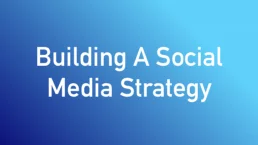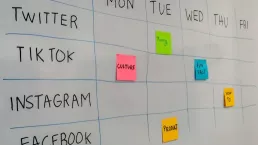This article covers the steps to identify good content to use through analytics, compeitor insights etc from the trello card
For many business owners and even those working in social media, creating a social media "plan" means looking at your business and thinking about what you can say to your audience that they might be interested in.
This is great but a small group of people can only think of so many ideas and eventually that means creativity starts to run dry, posts become dull and your socials aren't an effective marketing channel for you.
That's why as part of our 0-60k campaign, we're sharing our framework for building, or refreshing your social media strategy.
What Is a Social Strategy?
The first thing to understand is the difference between a group of social media post ideas and a social media strategy.
The main reason businesses post on social media is to grow an audience that they can sell to, whether immediately or in the future. Yes there are secondary reasons such as to inform existing customers about your business, but thinking bigger, this helps to engage customers and keep them shopping with you.
Individual post ideas will help achieve individual objectives, but a strategy takes those individual ideas and applies a layer of thinking so that posts work together and help target the right audience at the right time.
To use a motorsports analogy, it's like a racing driver coming into the pits to change tyres when the pit team aren't ready and waiting. Spearately these actions both need to happen for a good pit stop, but without each considering the other the pitstop is less effective.
DO Digitel Social Media Framework
So how do you build a robust social media strategy and plan? Here's our framework for building your own social media strategy and plan.
Social Media Strategy Preparation
It might not sound ecxiting, but the first step is research. Here's the hard truth though, the more time you invest here the higher the chance of success when you start publishing content.
We'd recommend thinking about the following:
- What are your goals and objectives
- Do you want to grow an audience?
- Are increased sales important?
- What audiences are you trying to reach
- Do you need to reach prospective customers?
- Perhaps you want to retain existing customers
- Which stagets of the buying cycle do you want to reach?
- Who are your competitors
- Don't just focus on your direct competitors
- There may be social sellers or other retailers you're not aware of
With these things in mind, you can better understand the types of content you need to create to meet your goals, but also the type of content your audience is looking for. While you want to sell to your audience, they won't want to be bombarded with sales posts.
Research Your Social Media Plan
When it comes to researching your social media plan, the good news is that there's already lots of information that you can use to help you. Take full advantage of the resources online already, remember you want to be working smarter, not harder!
Social Media Content Calendars
A quick look online will reveal that there are plenty of social media agencies who have already created annual calendars full of annual days.
These provide a quick and easy way to connect with audiences through shared passions. Look for annual days that are relevant to your business or that your audience care about.
Even if you've not finished the rest of your research, you can start to post around these days immediately.
Social Competitor Research
It's highly likely that your competitors will have a social media presence and you can use this to your advantage. Ask yourself the following questions:
- How often are competitors posting
- What types of content do they post
- Is it sales content, marketing or a mix of both?
- Are they using static or video assets?
- Do they post the same content everywhere
- Does their content attract engagement
- If no-one's liking and sharing it, what's the point?
You might find that your competitors aren't actually that active on social media. It's easy to get drawn into thinking everyone is doing everything better than you, but it's not until you take the time to really look at your competitors are doing that you truly understand your opportunity.
Don't cut corners here either, look at 3 or more competitors across a range of social media sites, this will help you understand if competitors are using the same content everywhere or customising content by social platform. Remember, an Insta image post won't work on TikTok.
Identify Key Business Dates and Events
The important annual events in your business can also be a great source of social content inspiration.
We're not talking about the annual submission of your accounts, but the commercial and other events that can give character and personality to your brand.
Think about things like:
- Awards
- Staff promotions
- Key sales periods
- Product developments
All of these and more can act as more than single post ideas, they give you topics that you can post about over several weeks. For example a new product development can be teased in the run up to release, then posted about afterwards, followed up by customer testimonial posts.
Cross Pollinate Social Content
When planning your social media strategy timings, you also want to consider the cross pollination of content.
Creating content takes time, so why not save some time by using content in multiple places? Created an image asset for Insta? Consider whether it can be used on other social channels.
Another opportunity comes in sharing content which may exist on your website. Perhaps you've written an insightful blog post, this content should also be shared on social as it not only gives you something else relevant to post about, but it also increases the reach of your content.
Buying Stage Content
Social media can give you a tremendous reach with new audiences who may never have been exposed to your brand before. Not all of these users will be ready to buy your products though.
Consider how you can create content that speaks to your different social media audiences, including those researching, considering and ready to buy.
You'll already know the key trading periods for your business, think about how you can vary your content in line with these, perhaps more conversion focused content during peak buying periods.
Creating Your Social Media Strategy
Once you've completed your research you can begin to create your own social media strategy. Using the research you've carried out, it's possible to begin planning social campaigns alongside individual posts which are targeted at your specific business needs.
At this stage it's important to remember not to post everywhere for the sake of it though! By this point you should know more about your audience and the platforms they use, so consider this in your plans.
Don't plan too far ahead either, 2-3 months ahead in detail is a good view but still provides flexibility, with a 12 month view containing key annual dates.
Take time to set targets for individual posts or campaigns too, this gives you something to work towards.
Review Your Performance
Finally, don't forget to review your performance against the targets you set, this is essential otherwise how do you know what's working and what's not?
It's surprising how many brands still fail to do this and learn from their activity. Getting this bit right can help you to optimise your strategy and stay ahead of the competition.




